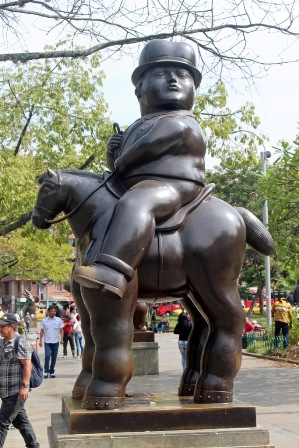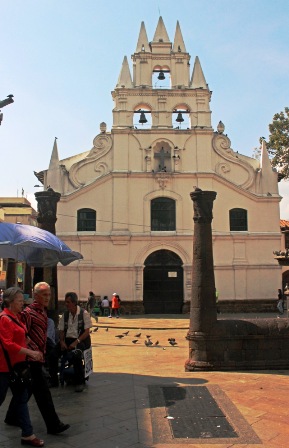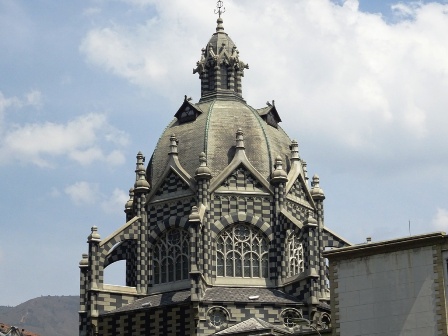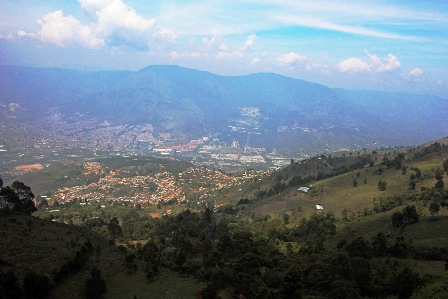
Click the photo above to see a Medellin album. Close the window to return.
Read Previous Episode: Mompox or Next Episode: Cali
January 19-22 2016
Wow, the whole plaza is full of chubbies! Oh, yes, Medellin (pronounced Made-a-jean) is the birthplace of Fernando Botero. All these sculptures in the Plazoleta de las Esculturas park, AKA Plaza Botero, in front of the art deco Museo de Antioquia, were donated by the artist, just as he did in Bogota for the Museo Botero. The artist certainly has a sense of humour. All these sculptures lend an air of fun and hopefulness to a city with a violent past. Ray and I busied ourselves snapping photos of several of the sculptures, trying to decide which ones were our favourites.
We had flown to Medellin, blessed with a climate called “eternal spring”, situated in a narrow valley, surrounded by jagged peaks, from Cartagena the day before. We stayed in a nice small hotel, called In House the Hotel, in the tourist friendly area of El Poblado, where restaurants vied for places with hostels and small hotels. Our Hotel was a 15 to 20 minute walk downhill to the Metro, which conveniently whisked us right to Parque Berrio, just steps from Plaza Botero, museums and the Colonial churches we wanted to visit.
After the Botero's sculptures, our destination was the Museo de Antiquia, named for the district of Antioquia, it housed a collection of pre-Colombian and colonial art with the main emphasis on modern art. Yes, there was a large collection of Fernando Botero's, but there was more. I especially appreciated the murals on the stairways, the work of Pedro Nel Gómez Agudelo, a contemporary of Diego Rivera. A special exhibit of installations by the new generation of Colombian artists, investigating themes of violence and emigration. tHere were good explanations of the artist’s intent and films to go along with their installation. We were both impressed and spent the rest of the morning in the museum.
We emerged from the museum at lunch time to find the streets lined with food and souvenir carts and more people in one place than we had encountered in Colombia so far. It was a colourful, happening place. We had lunch in a really good value vegetarian restaurant, Govinda, the haunt of many Colombian Hare Krishna types and lots of business people who know a good deal when they see one.
That set us up to visit several colonial churches in the area. The most attractive for us was the small Ermita de la Veracruz, a colonial church constructed in 1803 on the grounds of the original 1682 church, right next to the Museo de Antiquia. A few blocks farther north was the red Adobe brick Metropolitan Cathedral of Medellin, in front of Bolivar Park, constructed over a 50 year period from 1875 to the 1920s. It was not open when we visited so we just admired the outside and the park. Our last stop was the Basilica de la Candelaria, which dates from 1863. We still preferred the simpler Ermita church..
 Ermita Church |
 Uribe Palace of Culture |
The Rafael Uribe Palace of Culture, in front of the museum, was so fascinating with its striped façade of red and cream brick, that we had to visit. It mostly houses municipal offices but there was a great view from a terrace on the top floor and a good exhibit of new artist’s work and the history of the building’s construction in the 1920s and 1930s.
If you want to see the best view of Medellin, take one of the two cable cars, that are transfers from the Metro system. We took the Metrocable branch towards the barrio Santo Domingo, then transferred to the line that services Arvi park. Yes the views were great, both going up and coming back down. Popular Arvi is both an ecological nature preserve and Pre-Hispanic archeological site on the eastern slopes of Aburrá Valley. The park covers 16,000 hectares, 1,760 of which are in the state of natural forests with 54 miles of walkable trails. We met a young Spanish woman on the cable car whom I had noticed getting on the same metro station as us in Poblado. Irma was travelling alone and was glad for the chance to speak some English. She became our unofficial translator for a Spanish only guided walk on one trail. Our guide, Daisy, kept our group of 30 visitors, all but us Spanish speakers, interested by talking about the history of the park and the flora and fauna. At the end of the walk we had a choice of continuing on to another section called the Piedras Blanca (white rocks) or going back to the park headquarters. It was lunchtime and the food vendors at the park headquarters beckoned.
 View of Medellin from cable car to Arvi Park |
We bought a sandwich, water and a bowl of soup to share for our lunch, just enough to set us up for an afternoon at the 14-hectacre Botanical Garden, conveniently located on the Metro line. The botanical garden has more than 1,000 living species and 4,500 flowers. We walked around most of the paths, through a rain forest area, around a pond and the orchidarium, where several of the collection of orchids were in bloom. A favourite section was the butterfly house, with several varieties, including Monarchs, flitted from flower to flower and stopping at the feeding stations offering tropical fruits suited to butterfly tastes.
The Medellin airport is one hour from the city, reached by driving up switch backs over one mountain and down into another, wider valley. Our plane for Cali was scheduled for 8:35 so the taxi was ordered for 5:30 AM to be at the airport 2 hours prior to takeoff. It was still dark when we started off. We kept passing bicyclists, with full gear and lots of lights, on the paved shoulder pumping up the hill. There were more than 20, strung out up the hill, a few with a motorcycle escort. They must be part of a bicycle club, hill training before the traffic and heat got worse.
We got to the terminal in plenty of time to find the flight had been delayed 20 minutes. We also discovered we had to have a printed version of our boarding pass for our Viva Colombia flight, rather than the electronic version. The check-in desk said they could print it for COP 25,000 each! I said you could buy a printer with that much. They did tell us we could get it printed at the info desk in the airport. We found the desk and were told we needed to send the boarding passes to her email. Luckily they have free internet service. It took multiple tries to get onto the service as it only allows so many customers at a time, but it worked. We got the tickets printed and at no cost. vIva Columbia airlines must be one of the last to embrace online boarding passes on a phone.
Oh well, our visit to Medellin ended well. We saw just a small part of what the city and the surrounding countryside had to offer. We are building up an inventory of places to visit on a future visit to Colombia.
|
Return to Travels
Return to Introduction